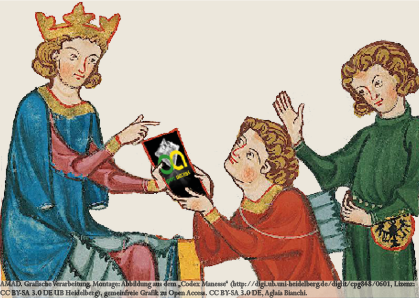AMAD
"Archivum Medii Aevi Digitale - Specialized open access repository for research in the middle ages"To submission

Full metadata record
| DC Field | Value | Language |
|---|---|---|
| Author | Hiltmann, Heiko | - |
| Date | 2011 | - |
| Other Identifier | https://nbn-resolving.org/urn:nbn:de:bvb:473-opus-3530 | - |
| Other Identifier | https://opus4.kobv.de/opus4-bamberg/frontdoor/index/index/docId/301 | - |
| Other Identifier | urn:nbn:de:bvb:473-opus-3530 | - |
| Other Identifier | https://opus4.kobv.de/opus4-bamberg/files/301/BIMS4HiltmannopusfinseA2.pdf | - |
| URI | https://www.amad.org/jspui/handle/123456789/78206 | - |
| Description | Im ausgehenden 9. Jahrhundert wurde Island von (überwiegend) norwegischen Auswanderern besiedelt. Für die Landnehmer begann eine Zeit der Unabhängigkeit von der norwegischen Krone. Im 10. Jahrhundert errichteten sie eine oligarchisch verfasste Ordnung, die aufgrund ihrer vermeintlich demokratischen Grundprinzipien in der Forschung bis heute häufig mit Begriffen wie ‚Freistaat’, ‚Commonwealth’ oder neuisländisch ‚þjóðveldi’ (dt. „Volksgewalt“) belegt wird. Nach einer Zeit innerer Konflikte und bürgerkriegsähnlicher Zustände in der ersten Hälfte des 13. Jahrhunderts wurde Island schließlich in den Jahren 1262 bis 1264 als tributpflichtiges Land in das norwegische Königreich integriert. Der sukzessiv erfolgende Integrationsprozess war mit grundlegenden sozialen und politischen Veränderungen verbunden. In dieser Zeit des Wandels verhandelten die Isländer intensiv über die Festschreibung ihrer eigenen Geschichte, die Definition ihrer eigenen Traditionen und über die Etablierung ihres eigenen unabhängigen Status. Diese Verhandlungen finden ihren Niederschlag in der altisländischen Sagaliteratur des 13. und 14. Jahrhunderts. Die vorliegende Arbeit geht der Frage nach, welche Auswirkungen die soziopolitischen Entwicklungen und Veränderungen im hoch- und spätmittelalterlichen Island auf das zeitgenössische Männlichkeitsbild hatten. Sie zeigt, dass insbesondere die Vergangenheits- und Vorzeitsagas ihren Verfassern als Präsentationsmedium eines zeitgenössischen sozialen Diskurses dienten, der auf Island über die Entwicklung des ‚freistaatlichen’ isländischen Mannes zum norwegischen Gefolgsmann geführt wurde. ; In the late 9th century Iceland was settled by (mostly) Norwegian emigrants. For those settlers a period of independence from the Norwegian Crown began. In the 10th century the settlers established a constitution for the country. Due to its supposedly democratic principles researchers up to this day have often been using words like 'Free State', 'Commonwealth' or the modern Icelandic term 'þjóðveldi' (literally "people's sway") to describe what was actually an oligarchic Icelandic constitution. After a period of internal conflict and civil war-like conditions in the first half of the 13th century Iceland was finally integrated as a tributary country into the Norwegian Kingdom in the years 1262 to 1264. The integrational process took place successively and involved fundamental social and political changes. During this time of change, the Icelanders intensively negotiated on writing their own history, defining their own traditions and establishing their own independent status. These negotiations are reflected in the Old Icelandic Saga Literature of the 13th and 14th centuries. The present study explores the question of what impact the socio-political developments and changes in Iceland in the High and Late Middle Ages had on contemporary perceptions of masculinity. The work shows that the authors of the Icelandic sagas – in particular those of the so called Sagas of Icelanders and the Legendary Sagas – used their texts as a medium to present a contemporary social discourse on the development of the Icelandic man from a member of the 'Free State' to a liegeman of the Norwegian Kingdom. | - |
| Format | application/pdf | - |
| Language | ger | - |
| Rights | info:eu-repo/semantics/openAccess | - |
| Keywords | Saga | - |
| Keywords | Online-Publikation | - |
| Keywords | ddc:940 | - |
| Keywords | Norwegen |Geschichte 1200-1400| | - |
| Keywords | Geschlechterrolle | - |
| Keywords | Island | - |
| Dewey Decimal Classification | 940 | - |
| Title | Vom isländischen Mann zum norwegischen Gefolgsmann. Männlichkeitsbilder, Vergangenheitskonstruktionen und politische Ordnungskonzepte im Island des 13. und 14. Jahrhunderts ; From Icelandic Men to Norwegian Liegemen. Images of Masculinity, Constructions of the Past and Concepts of Political Order in Medieval Iceland (13th-14th centuries) | - |
| Type | doctoralthesis | - |
| Type | doc-type:doctoralThesis | - |
| AMAD ID | 556920 | - |
| Year | 2011 | - |
| Open Access | 1 | - |
| Appears in Collections: | BASE (Bielefeld Academic Search Engine) General history of Europe | |
Files in This Item:
There are no files associated with this item.
Items in DSpace are protected by copyright, with all rights reserved, unless otherwise indicated.

